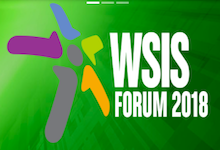ALFM Action Line C5: Blockchain as an enabler of security and trust
22 Mar 2018 14:30h - 16:15h
Event report
[Read more session reports from the WSIS Forum 2018]
The objective of this session was to provide a better understanding of blockchain technology, and its relevance to security; analyse and evaluate the current status of blockchain technology; explain its uses and potential policy and regulatory implications; and reflect on the future of the technology.
Moderator Mr Kemal Huseinovic, chief of the Infrastructure, Enabling environment and e-applications department at the International Telecommunication Union (ITU), spoke of the advantages of blockchain, its relevance, and how it can be an enabler of security and trust.
Mr Bilel Jamoussi, chief of the Study groups department at the ITU Standardization Bureau, highlighted the work being carried out by ITU study groups on blockchain to develop international standards in security. Responding to a question he shared that all of the best practices on Blockchain, are available on the ITU website under the Focus Group DLT section.
Mr Heung Youl Youm, chairman of the ITU-T Study group 17 on security, spoke briefly on the group’s initiatives, including the study on blockchain.
Mr David Manset, CEO of Be-Studys, spoke about blending privacy and security into blockchain, citing the example of the pilot experiment called www.myhealthmydata.eu which they are conducting in the area of healthcare. In this programme, they mobilise healthcare data while maintaining the privacy of the data using dual blockchain architecture. The system, he shared, has privacy by design and uses blockchain as a legal automation tool and is compliant with the General Data Protection Regulation (GDPR) model.
Ms Kyeong Hee Oh, Rapporteur for the ITU-T Study group 17, Q14/17 ‘Security aspects for distributed ledger technologies’, addressed the security aspects for distributed ledger technologies (DLT), highlighting Study group 17’s initiatives, including their current activities and future plans. She elaborated on the study questions the working group is looking at, such as how security aspects can be identified; how vulnerabilities will be handled; what security technologies will be required to support apps and services; what security parameters would be required for protocols; best practices and guidelines; and others. She shared the three layers used in the standardisation roadmap for Q14: platform security for DLT platform; security for DLT applications, and security management for DLT.
Mr David Wen, chairman of the ITU-T Focus group on digital currency including digital fiat currency (FG-DFC), elaborated on what is digital currency and explained the distinction between DLT and digital currency. He spoke about the multiple layers of digital currency and gave the example of the Bank of China. Wen also highlighted the work the focus group on digital currency at the ITU is carrying out, including looking at new applications for digital currency, such as DFC. He added that the working group was looking at different forms of digital currency which would be compliant, will be beneficial for people, and will have an economic impact.
While responding to the question of cryptocurrency and Bitcoin being described as ponzi schemes, Wen shared that they are trying to gather information on all such cases in order to share with the public although at this point, with limited data on the subject, it is difficult to comment.
Ms Ke Wang, project manager of the Study project on blockchain, China Mobile Research Institute, presented the telecom operators’ view on blockchain, and spoke about the relationship between blockchain and security. She highlighted the potential of blockchain for telecom operators in terms of process, building trust, and providing integrated and expanded services to customers. The issues with blockchain technology, she shared, were issues related to certificate management and batch enrolment; issues of trust between different certificate authorities (CA); high energy consumption by blockchains; and security issues. She further explained the benefits of blockchain-based public key infrastructure (PKI) systems, which her organisation has implemented.
Mr Ghassan Karame, manager of Security Group and chief security researcher, NEC Laboratories Europe, spoke about the NEC’s research on blockchain. He emphasised that the benefit of blockchain depends on the specific use. He shared NEC research concerning the analysis of the security and privacy provisions of existing blockchain technologies and the design and implementation of a number of efficient security countermeasures. He explained that NEC Laboratories has been working to understand how blockchain works when applied in different scenarios, and to analyse where it would work well. Karame also highlighted the new architecture for blockchain ‘satellite chains’ proposed by NEC, and how this technology can address existing blockchain challenges.
By Amrita Choudhury
Related topics
Related event

